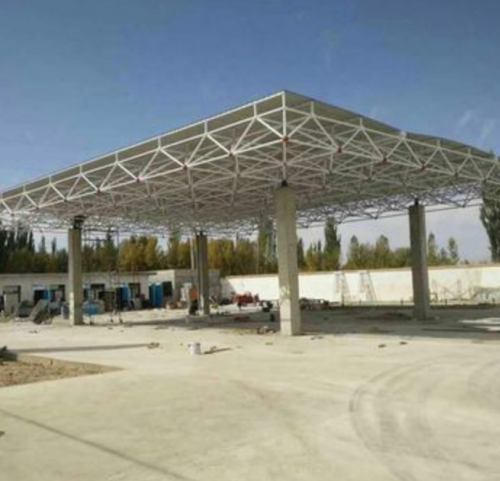
The gas station grid is an important component of the gas station, mainly used to support the ceiling, protect refueling equipment and vehicles from weather conditions. Here are some key points about the gas station network structure:
1. Structural composition
Column: Supports the entire grid structure, usually made of steel.
Beam: Connecting columns to increase stability.
Purlin: Supports the ceiling material and is horizontally fixed on the crossbeam.
Ceiling: Covering the top of the grid, commonly used materials include color steel plates, sun panels, etc.
2. Material selection
Steel: Q235 or Q345 is commonly used, with high strength and good durability.
Anti corrosion treatment: Usually hot-dip galvanizing or spraying anti-corrosion coatings are used to cope with harsh environments.
Ceiling materials: color steel plates, sun panels, membrane structures, etc., which need to have characteristics such as fire resistance, corrosion resistance, and UV resistance.
3. Design points
Load calculation: Consider loads such as wind, snow, and self weight to ensure structural safety.
Seismic design: Conduct seismic design based on local seismic intensity.
Drainage design: The ceiling should be designed with a reasonable slope to prevent water accumulation.
Ventilation and lighting: Ensure good ventilation and sufficient lighting.
4. Construction steps
Foundation construction: Carry out foundation construction according to design requirements.
Column installation: Ensure verticality and accurate positioning.
Installation of crossbeams and purlins: Install in sequence to ensure a secure connection.
Ceiling installation: Lay the ceiling material and fix it.
Anti corrosion treatment: Conduct anti-corrosion treatment after construction is completed.
5. Maintenance and Inspection
Regular inspection: Check whether the structure is deformed, corroded, or loose.
Cleaning and maintenance: Regularly clean the ceiling to prevent dust and debris accumulation.
Anti corrosion treatment: Regularly inspect the anti-corrosion layer and reprocess it if necessary.
6. Safety requirements
Fire prevention: Materials must comply with fire prevention standards.
Lightning protection: Install lightning protection facilities to prevent lightning strikes.
Identification and Warning: Set up necessary safety signs and warning signs.
7. Environmental Protection and Energy Conservation
Energy saving design: using energy-saving materials such as solar panels.
Environmentally friendly materials: Choose recyclable or eco-friendly materials to reduce environmental impact.
8. Cost control
Material selection: Choose materials with high cost-effectiveness while ensuring quality.
Construction management: Optimize the construction process and reduce waste.
9. Common Problems
Corrosion: Regular anti-corrosion treatment is required.
Deformation: Load should be considered during design, and quality should be ensured during construction.
Poor drainage: During design, it is necessary to ensure that the drainage system is reasonable.
10. Future Development Trends
Intelligence: Introduce intelligent monitoring system to monitor the structural status in real time.
Green and environmentally friendly: Use more environmentally friendly materials to reduce carbon emissions.
Modular design: Adopting modular design to improve construction efficiency
Through reasonable design, construction, and maintenance, the gas station network can effectively protect refueling equipment and vehicles, ensuring the safe operation of gas stations.
Category: Gas station network frame